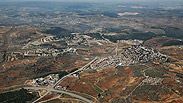
Gush Etzion. 'When you have to annex, annex. Don't talk'
Photo: Ilan Arad
The community of Gvaot is not far from my home. Several families, an educational institution and an exposed mountain which has seen better days. A short distance as the crow flies, but a long distance politically.
Forty-seven years have passed since the reoccupation of Gush Etzion,
and there is still no news.
My community was built on the Seam Line in the 1950s. Gvaot was built in 1984 beyond the Green Line. First as a Nahal settlement and a pioneering force for a kibbutz which was never established, and then as a community waiting for news.
Timing
Itay Blumenthal
'What good does this do at a time like this?' finance minister says, criticizing timing of Israel's decision to expropriate some 4,000 dunam of West Bank land.
The differences between the eastern and western side of the Green Line stand out. In the veteran communities in my area, extensions are being built with stone buildings, trees are being planted, schools are being opened, agricultural lands are yielding field produce and real estate.
On the other side, the lands produce havoc. Every development plan turns into a main headline, every dunam is counted by workers in foreign embassies in Tel Aviv. The residents, private people, are only examined by their government's policy. There are no property rights, only a political dispute. Here and overseas.
And there are additional differences: My moshav was built on the ruins of the village of Bayt ʿIṭāb. A total of 606 residents fled, and 187 homes were captured during the War of Independence. My house is located on the land of occupation.
Gvaot, on the other hand, was built on exposed land, in an area which no one resided in, where no homes were built and no vineyards were planted. Jews did settle nearby: Kibbutz Kfar Etzion, a continuation of the kibbutzim of the Hashomer Hatzair and Religious Kibbutz movements, which were established in the 1930s in order to protect Jerusalem and were deserted in 1948.
The Gush Etzion story has all the consensus components: A Zionist ethos, a combat history, a cooperative settlement movement and a moderate religious Zionism of the old type, but it also contains every possible mistake.
I pass there often, travelling though the Tunnels Road on my way to Jerusalem, sometimes setting a meeting at the junction where the three teens were kidnapped. The roads are new, the lighting system works and on the sides of the road there are signs in Hebrew and Arabic warning drivers to beware. The sight conveys normalcy, but when it comes to construction the normalcy fades away.
The State of Israel must examine itself: How is it possible that a declaration of 4,000 dunams as state land achieves the counter effect? How is the consensus around Gush Etzion being dissolved?
This question is emphasized when one examines the stances of Israel's prime ministers throughout the generations. The Allon Plan (to divide the West Bank between Israel and Jordan) and the peace proposals – from Ehud Barak in 2000 to Ehud Olmert on the eve of the end of his term as prime minister- defined Gush Etzion as a line which shall not be crossed. The lines are bent and become entangled, as long as the Gush Etzion land is not handed over to the Palestinians. The same applies to the Clinton Parameter and the agreements of President George W. Bush.
So what happened? Where did we lose this bloc of communities? The answer is concealed in the international community's limitations to distinguish between lines and history, but as important – in the limitations of the Israeli politics to create agreements.
There is no reason to build in Gush Etzion as an act of retaliation against terror attacks. There is no reason to appropriate state lands just as a political act of retaliation for critics within the government. There is no real reason for Gush Etzion to be in the same bundle as the complexity of the rest of the areas in Judea and Samaria.
The right's inability to create an agreement with the left in regards to Gush Etzion is eroding the area's special status, and worse – the international lines of agreement which have already been achieved.
If we want to annex Gush Etzion, we must create an organized construction plan, outlines and a citizenship process for the Palestinians living in the area. This is a tolerable price for expanding the normalcy and narrowing the conflict area.
I will support annexation with all my might, but at the moment we are seeing nothing but declarations. This is the new Israeli method: Making declarations as an alternative for making decisions.
"When you have to shoot, shoot. Don't talk," says the famous line from "The Good, the Bad and the Ugly." When you have to annex, annex. Don't talk.
















